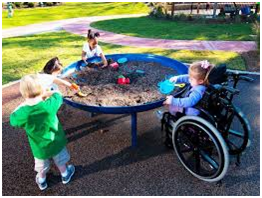Lesson 9: Adapting Learning for Young Children with Special Needs (Part 1)
Attention

What would you do to the environment to make it easier for the child in the wheelchair to participate fully in the activity?
Learning Outcomes
Upon completion of this lesson's material, students will be able to
- Discuss adaptations appropriate materials and equipment for working with young children with special needs at home and in educational environments.
Teaching
In earlier courses you learned about adapting for cognitive delays, but adapting for social and emotional delays or disabilities is a little different and require different strategies. This week, you read about the different social and emotional delays or disabilities and different adaptations and strategies you can use in your own practice. Adapting appropriate materials and equipment and implementing instructional strategies enables children to maximize their potential in both home and school environments.
This is why it is critical for early interventionists and early childhood special educators to identify adaptations for children with a variety of developmental delays. It is important to note that educators and specialists should not assume that all children with cognitive delays share the same challenges to as those who have learning difficulties. Special Education programs should work towards maximizing the potential of students to minimize the impact of their developmental deficits. There are several components that are necessary to support the individual needs of a child with special needs in an inclusive learning environment.
These components are
- Curriculum modifications and adaptations
- Embedded learning opportunities
- Explicit, child-focused intervention or instructional strategies
Adapting the Home & Classroom Environment
Teachers and parents should start with the child's interest in mind. Professionals often recommend embedding intervention or instruction into typical classroom activities and routines. For example, a consistent routine provides the child with security and promotes self-assuredness.
Adapting Materials and Equipment
There are many ways teachers can adapt materials and equipment to help children with special needs learn.
For example,
- Plan hands-on and multi-sensory activities
- Use visual cues when necessary to prompt children to follow the classroom activities and exhibit appropriate behavior.
- Present abstract concepts in multiple ways
- Generalization is learning to use a skill outside of the context in which it was initially acquired.
- Task Analysis – an instructional strategy often used with children with cognitive delays: Involves breaking down a skill or activity into smaller, more manageable steps
- Scaffolding – a teacher directed activity wherein the teacher provides various forms of support to help a child learn a new task
Adapting for Social & Emotional Delays or Disabilities
As a teacher, you will modify the environment differently for each child with social and emotional delays or disabilities. Similarly, you many choose different instructional strategies.
Example #1 Take for example a child with difficulty regulating her emotions. The child has been having difficulty waiting for a turn. Some environmental strategies you may choose are to provide more than one of the toys or materials or another similar item to be used with two children at a time so taking turns does not impede the educational piece or the sharing component. Some teaching strategies you might choose are to model language for the child: "May I please have a turn with the drum when you are done?" or "Let's count to 20, then it will be your turn".Another teaching strategy may be to create a social story that talks about waiting for a turn with the previous strategies along with a page that explains how to respond to a peer who says "you can have a turn when I am done" or says "No" with age approopriate written responses in the book/story.
Example #2 For a child who has a tendency to run away, bolt or engage in unsafe behaviors, it is important to remind the child that it is your job to keep him and his classmates safe. It is important to provide verbal praise, high fives, fist bumps or pats on the back to this child as you "catch him being good", and to discuss safety concerns in individual, small and large group opportunities. Some environmental adaptations needed may be to print up STOP igns and put them in the appropriate places.
When adapting Materials and Equipment, ask yourself these questions:
- Are materials used for self-expression readily available?
- Are learning materials safe and do they promote various social interaction?
- Are there enough materials?
- Are the materials reinforcing to children?
When using materials,
- Use materials that are ased on the child's interest.
- Place materials in a location where the child can see them but is unable to access them.
- Limit the amount of materials so children can make choices
When adapting instruction,
- Imitate the child's actions and sounds
- Use words and gestures when necessary
- Use pauses (verbally and phyisically) to provide opportunity to communicate
- Collaborate with related service personnel (such as the SLP)
Assessment
Lesson 9 Discussion
After reading Chapter 8, reflect on the adaptations you have seen or used, read about, or will be using in your research paper. Thinking about these adaptations, explain how they can be acquired and proper training on their use occur for families. Also discuss how to use adaptations in the classroom that are developmentally appropriate In your explanation, specify the child’s age and the number of staff and children in the environment. Discuss at least (4) adaptive materials.